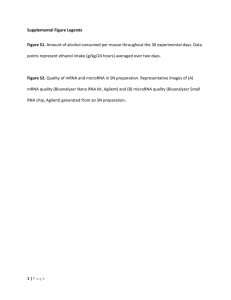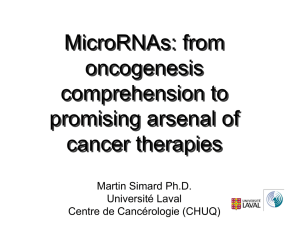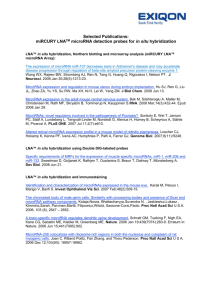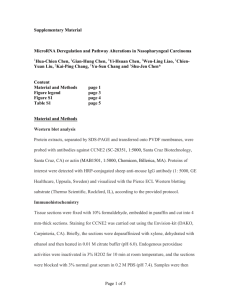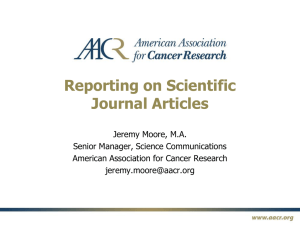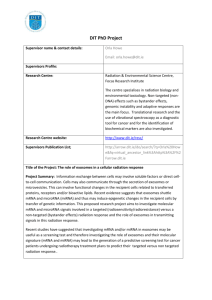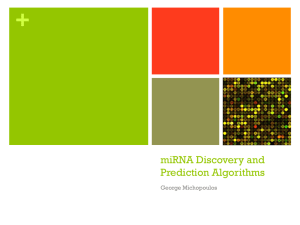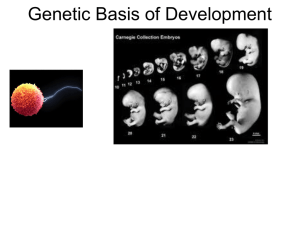Research Fund 2012/2013- Tranche 2 Dr Lyne Jossé Developing
advertisement
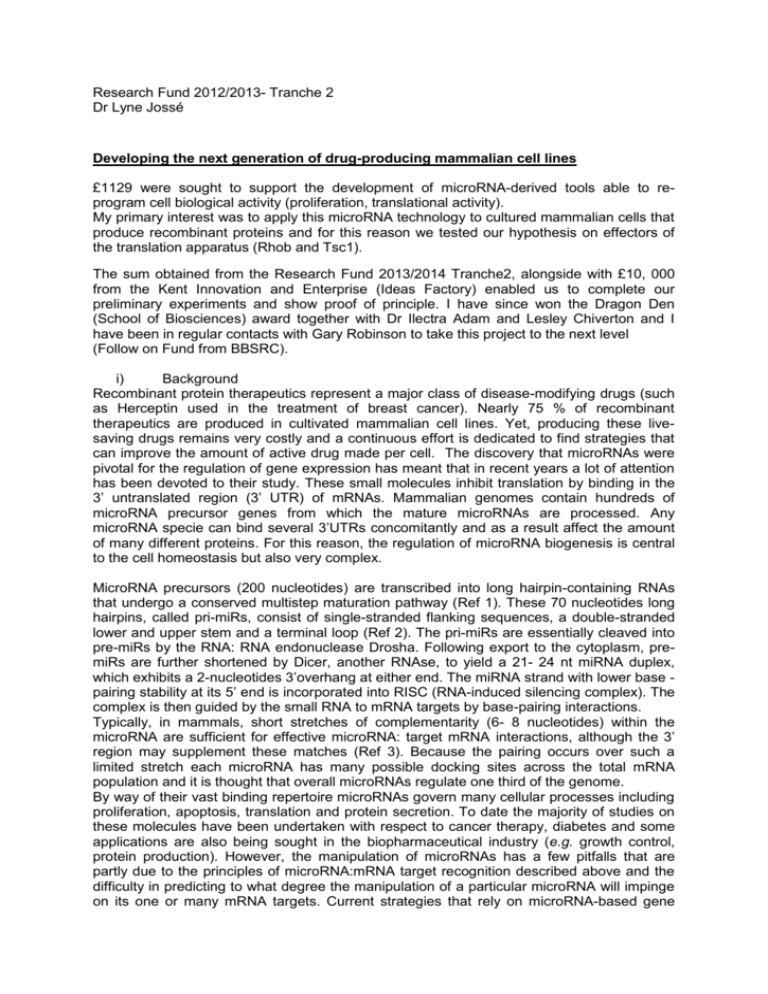
Research Fund 2012/2013- Tranche 2 Dr Lyne Jossé Developing the next generation of drug-producing mammalian cell lines £1129 were sought to support the development of microRNA-derived tools able to reprogram cell biological activity (proliferation, translational activity). My primary interest was to apply this microRNA technology to cultured mammalian cells that produce recombinant proteins and for this reason we tested our hypothesis on effectors of the translation apparatus (Rhob and Tsc1). The sum obtained from the Research Fund 2013/2014 Tranche2, alongside with £10, 000 from the Kent Innovation and Enterprise (Ideas Factory) enabled us to complete our preliminary experiments and show proof of principle. I have since won the Dragon Den (School of Biosciences) award together with Dr Ilectra Adam and Lesley Chiverton and I have been in regular contacts with Gary Robinson to take this project to the next level (Follow on Fund from BBSRC). i) Background Recombinant protein therapeutics represent a major class of disease-modifying drugs (such as Herceptin used in the treatment of breast cancer). Nearly 75 % of recombinant therapeutics are produced in cultivated mammalian cell lines. Yet, producing these livesaving drugs remains very costly and a continuous effort is dedicated to find strategies that can improve the amount of active drug made per cell. The discovery that microRNAs were pivotal for the regulation of gene expression has meant that in recent years a lot of attention has been devoted to their study. These small molecules inhibit translation by binding in the 3’ untranslated region (3’ UTR) of mRNAs. Mammalian genomes contain hundreds of microRNA precursor genes from which the mature microRNAs are processed. Any microRNA specie can bind several 3’UTRs concomitantly and as a result affect the amount of many different proteins. For this reason, the regulation of microRNA biogenesis is central to the cell homeostasis but also very complex. MicroRNA precursors (200 nucleotides) are transcribed into long hairpin-containing RNAs that undergo a conserved multistep maturation pathway (Ref 1). These 70 nucleotides long hairpins, called pri-miRs, consist of single-stranded flanking sequences, a double-stranded lower and upper stem and a terminal loop (Ref 2). The pri-miRs are essentially cleaved into pre-miRs by the RNA: RNA endonuclease Drosha. Following export to the cytoplasm, premiRs are further shortened by Dicer, another RNAse, to yield a 21- 24 nt miRNA duplex, which exhibits a 2-nucleotides 3’overhang at either end. The miRNA strand with lower base pairing stability at its 5’ end is incorporated into RISC (RNA-induced silencing complex). The complex is then guided by the small RNA to mRNA targets by base-pairing interactions. Typically, in mammals, short stretches of complementarity (6- 8 nucleotides) within the microRNA are sufficient for effective microRNA: target mRNA interactions, although the 3’ region may supplement these matches (Ref 3). Because the pairing occurs over such a limited stretch each microRNA has many possible docking sites across the total mRNA population and it is thought that overall microRNAs regulate one third of the genome. By way of their vast binding repertoire microRNAs govern many cellular processes including proliferation, apoptosis, translation and protein secretion. To date the majority of studies on these molecules have been undertaken with respect to cancer therapy, diabetes and some applications are also being sought in the biopharmaceutical industry (e.g. growth control, protein production). However, the manipulation of microRNAs has a few pitfalls that are partly due to the principles of microRNA:mRNA target recognition described above and the difficulty in predicting to what degree the manipulation of a particular microRNA will impinge on its one or many mRNA targets. Current strategies that rely on microRNA-based gene regulation interfere with the mRNA/microRNA ratio by changing the miRNA levels in the cells or accessibility to the 3’UTR. These include antisense-mediated inhibition of over-expressed microRNA (anti- miRNA oligonucleotides), preventing microRNA docking by using miRmasks that are complementary to the 3’UTR of the target, or replacement of underexpressed microRNAs by microRNA mimics (Ref 4). ii) Project outline The basis of this research project was to develop synthetic precursor of microRNAs that selectively affect the expression of a protein of choice- one protein and one only. Ultimately, I wanted to generate mutant microRNA precursor that will permit the adaptation and optimisation of cellular mechanisms and enhance cell-derived therapeutics production. As seen in the schematic below, mammalian mature microRNA only partly bind to their target mRNA (Figure 1). This makes it difficult to accurately predict their putative binding target and current target prediction software generate a lot of false positive hits or overlook possible targets. It is essential to validate microRNA/ 3 ‘UTR interaction experimentally at the start of any such project. By rule of thumb the distance between the Drosha- Dicer cleavage sites is between 21-24 nt. For example, a two- nucleotides insertion that encompasses the mature sequence will shift the dicer cleavage site two nucleotides upstream (Ref 4). However, this can be circumvented by adding an asymmetrical bulge somewhere else in the stem loop- within the mature sequence (Ref 5). u u ---- ag gcag cc cuguuaguuuugcauag uugcac uaca a |||| || ||||||||||||||||| |||||| |||| a cguc gg gguagucaaaacguauc aacgug augu g c u ua uug aa u u ----- ag gcag cc cuguuaguuuugcauag uugcac uaca a |||| || ||||||||||||||||| |||||| |||| a cguc gg gguagucaaaacguauc aacgug augu g c u aga uau aa Figure 1- hsa-miR-19a stem loop structure. The mature microRNA is generated (red letters) following cleavage with RNAse: RNAse enzymes on the 5’ or 3’ arm. Letter highlighted in grey are perfect match with the target Rhob 3’UTR. Blue letters are mutations or insertions that lead to higher binding specificity between the microRNA add its target. To . Wild-type Bottom- Asymmetrical mutant 1 for targeting Rhob 3’UTR more specifically. iii) Results We initially targeted proteins that are involved in the translation machinery (Rhob/ mTOR and Tsc1/ mTOR pathway). A 80 % Rhob inhibition by miR-21 has recently been shown to lead to 1.86 fold increase in cyclin D1 translation (5). According to the microRNA targets prediction software TargetScan (http://www.targetscan.org/) Rhob 3’UTR is also targeted by miR-19a. The microRNA miR-21 and miR-19a are linked to Rhob regulation but can regulate many other genes. For example, both miR-21 and miR-19a are also predicted to target Tsc1 3’UTR. The preliminary work described below has been carried out by Ilectra Adam under the Ideas Factory scheme (see section (i)). Ilectra Adam has cloned: a ) the wild-type pri-miR sequences of hsa-miR19a and hsa-miR21 into the mammalian expression vector pcDNA4/ His Myc and b) TSC1, Rhob1, 3’UTRs downstream of plasmid-borne Renilla Luciferase. In the first instance, hsa-miR-19a and hsa- miR-21 interaction with Tsc1 3’ UTR (and to a lesser degree Rhob 3’UTR) were confirmed by transiently co-transfecting the pri-miR constructs and Renilla luciferase derivatives in HEK293 cells. Six mutated precursors were the created, three hsa-miR19a mutated precursors designed to only target Rhob 3’UTR (placed downstream of Renilla luciferase) and three designed to only target Tsc1 3’UTR. Figure 2 show that replacement of wild-type 3’UTR (RLuc) by Tsc1 3’UTR (Tsc1) or Rhob1 3’ UTR (Rhob1) leads to greater translational activity in the presence of the endogenous miR-19a. The repression was enhanced when our “made to target “synthetic microRNA precursor were added. A similar outcome was observed for mir-21 mutants (data not shown). 50000 Rluc activity 40000 30000 20000 10000 0 uc Rl / p a 19 c lu /R a 19 1 sc T / 1 1 1 1 1 1 1 sc sc sc ob ob ob ob T T T h h h h R R R R 1/ 2/ 3/ a/ 4/ 5/ 6/ ut ut ut t t t 9 u u u m m m 1 m m m microRNA/ 3' UTR Figure 2- Level of repression of Renilla Luciferase (RLuc): in wild-type constructs (Rluc) or modified Renilla with Tsc1 or Rhob1 3’UTRs in the presence of wild-type mir19a (19a) or mutagenized 19a (mu1,2,3,4,5 and 6). Mut1,2 and 3 were designed to target Tsc1 and Mutants 4,5, 6 were designed to target Rhob1. iv) Conclusion Our data indicate that our hypothesis was sound and we want to apply to a broader panel of targets. 1- Winter J, Jung S, Keller S, Gregory RI, and Diederichs S. (2009) Many roads to maturity: microRNA biogenesis pathways and their regulation. Nat Cell Biol 11, 228-34. 2- Han J, Lee Y, Yeom KH, Nam JW, Heo I, Rhee JK, Sohn SY, Cho Y, Zhang BT and Kim VN. (2006) Molecular basis for the recognition of primary microRNAs by the Drosha-DGCR8 complex. Cell 125, 887-901. 3- Bartel DP (2009) MicroRNAs: target recognition and regulatory functions. Cell 136, 21533. 4- McDermott AM, Heneghan HM, Miller N and Kerin MJ (2011) The therapeutic potential of microRNAs: disease modulators and drug targets. Pharm Res 28, 3016-29. 5- Starega-Roslan J, Krol J, Koscianska E, Kozlowski P, Szlachcic WJ, Sobczak K and Wlodzimierz J. Krzyzosiak WJ (2011) Structural basis of microRNA length variety. NAR 39 (1) 257-268. 6- Ng R, Song G, Roll GR, Frandsen MN and Willenbring H (2012)- A microRNA-21 surge facilitates rapid cyclin D1 translation and cell cycle progression in mouse liver regeneration. J Clin Invest. ; 122(3):1097–1108 doi:10.1172/JCI46039.

